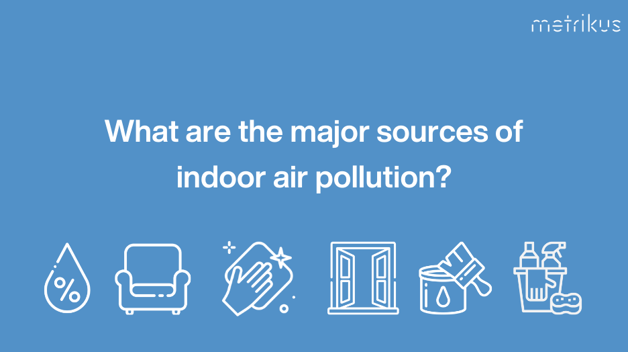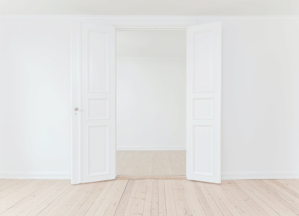What are the major sources of indoor air pollution? | The effects on air quality and health
What is indoor air pollution (IAP)?
Indoor air pollution (IAP) refers to the pollutants found in indoor environments, and it has become a major issue in recent times due to the increased amount of time that people spend indoors.
Exposure to IAP can lead to significant health concerns such as cardiovascular disease, respiratory illnesses, sick building syndrome, and even cancer.
Indoor air quality (IAQ) problems primarily stem from indoor pollution sources that release gasses and particles into the atmosphere. Poor ventilation is also a common cause of air quality issues, as it prevents emissions from these sources from being adequately diluted.
In this blog post, we explain the sources and health impacts of some key pollutants, and share some steps you can take to improve your indoor air quality.
.png?width=750&height=420&name=What%20is%20indoor%20air%20pollution%20(IAP).png)
Sources of indoor air pollution
Indoor air pollution can come from a variety of sources, some which are easy to spot and others which are slightly less obvious. The most common sources include inadequate ventilation, mold growth, HVAC systems, cleaning products, and building materials.
Inadequate ventilation and mold growth
When there’s not enough outdoor air entering indoor spaces, pollutants from various sources – such as cleaning products, off-gassing furniture or building materials – can accumulate at unhealthy levels. Inadequate ventilation can also cause excess moisture buildup which can lead to mold growth and leave a space feeling damp and uncomfortable.
Aside from its unsightly appearance and unpleasant odor, mold can pose serious health risks to occupants. It releases a range of toxins into the air, causing a range of symptoms, from mild allergies to severe respiratory issues like asthma attacks.
HVAC systems
Heating, ventilation, and air conditioning (HVAC) systems have an important role to play in improving your indoor air quality. But if they’re not cleaned properly, they can actually end up making matters worse.
Dirty HVAC systems can end up circulating dust, bacteria, and mold spores around your space, so proper maintenance and cleaning is absolutely key.
Volatile organic compounds (VOCs)
VOCs comprise a wide range of chemicals, which are emitted by things like cleaning products, furniture, sealants and paints. Common types include benzene, ethylene glycol, formaldehyde, and methylene chloride.
Concentrations of VOCs are often up to ten times higher indoors than outdoors, so it’s important to keep your space ventilated and avoid using products that emit VOCs where possible.
Building materials and furnishings
Asbestos
Asbestos was banned in the US in 1989 and in the UK in 1999, but it can still be found in around 20% of public and commercial buildings.
When asbestos fibers are breathed in, they can cause serious conditions such as asbestosis and mesothelioma, so if it’s found in a space, it should always be dealt with by professionals.
Carpets
Carpets can trap pollutants and allergens like dust mites, pet dander, mold spores, dirt and dust. And once absorbed into the fibers of carpets, these pollutants can be easily disturbed by just walking on them, negatively impacting indoor air quality.
This means it’s important to clean carpets regularly, ideally with a vacuum cleaner equipped with a HEPA filter.
How does outdoor air enter a building?
Ventilation brings in outdoor air to dilute indoor contaminants , but this can inadvertently introduce even more pollutants to the inside environment.
Outdoor air pollutants can also infiltrate indoor air in ways that may not be immediately obvious, through open windows and doors, and cracks in walls, doors and window sealants.
And this outdoor air is not as ‘fresh’ as you might think – according to IQAir, 10-100% of indoor air consists of outdoor air pollution, and once inside, pollutants can accumulate at extremely high concentrations.
Radon
Radon is an invisible, naturally occurring gas that’s produced by the breakdown of uranium and radium, which are found in rocks and soils in granite areas. Radon levels tend to be fairly low outside, but once it’s trapped indoors, it can exist in dangerous amounts.
Exposure to high doses of radon over a long period of time can increase the risk of developing lung cancer, so it’s vital to test regularly for radon levels so that any issues can be resolved quickly.
How does indoor air pollution affect human health?
Indoor air pollution is a major concern when it comes to human health.
The table below – from the International Journal for Environmental Research and Health – highlights some of the main indoor air pollutants and their potential impacts.
What are the symptoms of sick building syndrome?
Poor ventilation and improper maintenance of air conditioning systems are responsible for a phenomenon known as sick building syndrome (SBS).
When fresh air exchanges are reduced in modern buildings, volatile organic compounds (VOCs) and other toxic chemicals accumulate indoors, leading to various health problems.
SBS symptoms usually occur when people spend prolonged periods of time indoors – they may include:
- Headaches, dizziness and fatigue
- Sore throat and coughing
- Irritated eyes or skin
- Blocked sinuses or runny nose
- Inability to concentrate
While the symptoms improve when you leave a building, they tend to return when you re-enter the same environment.
Immediate effects of exposure to polluted air
The effects of indoor air pollution can be noticeable very soon after exposure and manifest into any of the symptoms explained above.
Although these immediate effects are not often severe or life-threatening, they can still impact your overall health, so it’s important to take steps to eliminate any source of pollution as quickly as possible.
Long-term effects of exposure to polluted air
Exposure to indoor air pollutants can have detrimental long-term effects on our health, causing respiratory diseases, heart disease, and cancer. These effects might not show up immediately after exposure, but can present themselves years down the line.
These chronic illnesses can significantly impact a person's quality of life and even lead to premature death. According to Our World in Data, air pollution – both indoor and outdoor – is the third biggest risk factor for leading causes of death worldwide and the fifth biggest killer in the UK.
How has mortality from indoor air pollution changed over time?
Although the above statistics are alarming, when it comes to indoor air pollution, it’s definitely not all doom and gloom. Since 1990, the progress in tackling indoor air pollution has driven a decline in related deaths worldwide.
And with the growth of Internet of Things (IoT), it’s easier than ever before to monitor and improve your indoor quality.
How to reduce indoor air pollutants
There are several ways to improve your indoor air quality.
1. Install indoor air quality sensors
Installing indoor air quality sensors is a very effective way to understand and improve your indoor environment. There are a huge range of sensors available that can monitor key factors, including temperature, humidity, CO2 and VOCs.
If you implement a smart building platform like Metrikus, alerts can be set up to notify you when these parameters deviate from their optimal zone so that steps can be taken to maintain a healthy indoor environment at all times.
2. Maintain HVAC systems effectively
As we’ve already mentioned, dirty or clogged HVAC filters can negatively impact IAQ by allowing contaminants like bacteria, allergens and even mold spores to build up within the units.
Maintaining HVAC systems and regularly changing air filters is key to reducing the concentration of pollutants indoors.
3. Optimize ventilation
Installing ventilation systems will keep the indoor air fresh. To prevent pollutants from creating low-quality, toxic air, high-quality ventilation should be put in place.
4. Maintain building appliances proactively
Performing preventative maintenance on all your building appliances can prevent them from becoming faulty, which can prevent toxic compounds from being released into the air.
5. Clean regularly and with the right products
Another simple way to improve your indoor air quality is to have your space cleaned more regularly, as pollutants often become attached to surfaces.
Many regular cleaning products release VOCs into the air, so it’s helpful to opt for natural and non-toxic products where possible.
6. Keep printers and photocopiers in a separate room
Printers and photocopiers should be kept in a separate, well-ventilated room as they can produce dangerous levels of ultrafine particles (UFPs) and ozone. Unlike stratospheric ozone, which forms naturally in the upper atmosphere and protects us from the sun's harmful ultraviolet rays, ground-level ozone can be harmful to human health.
7. Introduce plants into your space
Indoor plants have long been thought to purify the air, but a recent study revealed that in order to make a substantial difference, you would actually need to fit between 10 and 1000 plants per meter squared in a room.
However, they are a great addition to any space, and there are a wide range of studies showing the general health and wellbeing benefits they can bring. There are also certain plants that are thought to be particularly good for indoor air quality, including snake plants, spider plants and peace lilies.
Read our blog post: Eight benefits of having plants in your office.
Get rid of indoor air pollutants
At Metrikus, we can help you to monitor and improve your indoor air quality, creating healthier environments for occupants.
To find out how we can help you, get in contact with our expert team today.




